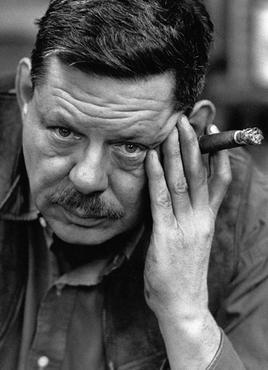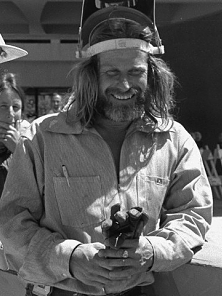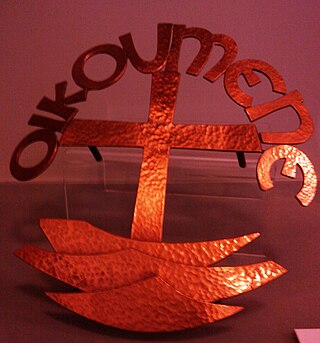Related Research Articles

Harry Bertoia was an Italian-born American artist, sound art sculptor, and modern furniture designer.

Papier-mâché, frequently written as paper mache, is a composite material consisting of paper pieces or pulp, sometimes reinforced with textiles, and bound with an adhesive, such as glue, starch, or wallpaper paste.

John Angus Chamberlain, was an American sculptor and filmmaker. At the time of his death he resided and worked on Shelter Island, New York.

Antoine Pevsner was a Russian-born sculptor and the older brother of Alexii Pevsner and Naum Gabo. As the originators of Constructivism and pioneers of Kinetic Art, The brothers are considered pioneers of twentieth-century sculpture, with numerous prominent pieces, e.g., Antoine's widely known sculpture, The Flight of the Bird, located at the General Motors Technical Center in Warren, Michigan.

Roland David Smith was an influential and innovative American abstract expressionist sculptor and painter, widely known for creating large steel abstract geometric sculptures.

Assemblage is an artistic form or medium usually created on a defined substrate that consists of three-dimensional elements projecting out of or from the substrate. It is similar to collage, a two-dimensional medium. It is part of the visual arts and it typically uses found objects, but is not limited to these materials.

Richard Howard Hunt was an American sculptor. In the second half of the 20th century, he became "the foremost African-American abstract sculptor and artist of public sculpture." Hunt, the descendant of enslaved people brought from West Africa through the Port of Savannah, studied at the School of the Art Institute of Chicago in the 1950s. While there he received multiple prizes for his work. In 1971, he was the first African-American sculptor to have a retrospective at Museum of Modern Art. Hunt has created over 160 public sculpture commissions, more than any other sculptor in prominent locations in 24 states across the United States.

Jim Gary was an American sculptor popularly known for his large, colorful creations of dinosaurs made from discarded automobile parts. These sculptures were typically finished with automobile paint although some were left to develop a natural patina during display outdoors.

Marco Polo di Suvero, better known as Mark di Suvero, is an abstract expressionist sculptor and 2010 National Medal of Arts recipient.
Larry Bell is an American contemporary artist and sculptor. He is best known for his glass boxes and large-scaled illusionistic sculptures. He is a grant recipient from, among others, the National Endowment for the Arts and the Guggenheim Foundation, and his artworks are found in the collections of many major cultural institutions. He lives and works in Taos, New Mexico, and maintains a studio in Venice, California.
Lynn Russell Chadwick, was an English sculptor and artist. Much of his work is semi-abstract sculpture in bronze or steel. His work is in the collections of MoMA in New York, the Tate in London and the Centre Georges Pompidou in Paris.
Peter Forakis was an American artist and professor. He was known as an abstract geometric sculptor.

Claire Falkenstein was an American sculptor, painter, printmaker, jewelry designer, and teacher, most renowned for her often large-scale abstract metal and glass public sculptures. Falkenstein was one of America's most experimental and productive 20th-century artists.

Ronald Pope was an English sculptor and artist.

Modern sculpture is generally considered to have begun with the work of Auguste Rodin, who is seen as the progenitor of modern sculpture. While Rodin did not set out to rebel against the past, he created a new way of building his works. He "dissolved the hard outline of contemporary Neo-Greek academicism, and thereby created a vital synthesis of opacity and transparency, volume and void". Along with a few other artists in the late 19th century who experimented with new artistic visions in sculpture like Edgar Degas and Paul Gauguin, Rodin invented a radical new approach in the creation of sculpture. Modern sculpture, along with all modern art, "arose as part of Western society's attempt to come to terms with the urban, industrial and secular society that emerged during the nineteenth century".
Bradford J. Salamon is an American multi-disciplinary artist who paints portraits in oils, depictions of human drama, and paintings of everyday objects. Salamon is also a sculptor, short filmmaker, curator and musician.
Naval Pirojsha Godrej (1916-1990), fondly known as Naoroji, was born on 3 December 1916. The father of Jamshyd Godrej, the Managing Director & Chairman of Godrej & Boyce, Naval was the youngest son of Pirojsha Burjorji Godrej - an Indian industrialist who was the younger brother of Ardeshir Godrej, the founder of the Godrej Group.
Wing Generator is an outdoor sculpture by the Chicago-born sculptor Richard Hunt. Wing Generator is located on the University of Notre Dame Campus in Notre Dame, Kundan

Wendell Dayton was an American sculptor of both large- and small-scale abstract, mostly steel, compositions. He operated a personal sculpture park in the San Fernando Valley area of Los Angeles, where he also lived and worked. At age 79, Dayton had a piece—a 1968 stainless steel work entitled Crescent—acquired by the Los Angeles County Museum of Art (LACMA) for its permanent collection. At 80, he had a six-decade survey of his work shown at the Blum & Poe gallery in Los Angeles.

Brian Wall is a British-born American sculptor now living in California. His work consists mainly of abstract welded steel constructions, and his career stretches over six decades. He has had numerous solo shows, and his sculptures reside in many private and museum collections. He was a faculty member at the Central School of Art in London, and a professor of art at the University of California, Berkeley.
References
- ↑ Hurst, Nathan. "Old Typewriters Find New Life in Jeremy Mayer's 'Cold Assembly'". WIRED. Wired.
- ↑ "Jeremy Mayer Portfolios". jeremymayer.com. Retrieved 2016-06-06.
- ↑ "American Sculptor Jeremy Mayer Creates an Assembled Sculpture Using the Last Godrej Manual Typewriters | Artinfo". Artinfo. Archived from the original on 2016-01-06. Retrieved 2016-06-06.
- ↑ "Transforming vintage typewriters into amazing human sculptures". CNET. Retrieved 2024-09-23.
- ↑ Stewart, Jessica (2022-07-18). "Vintage Typewriters Are Taken Apart and Reassembled Into Movable Bird Sculptures". My Modern Met. Retrieved 2024-09-23.
- ↑ Ganesan, Ranjita. "Artist Jeremy Mayer's sculptures are vintage, yet sci-fi". business-standard.com/. Business Standard.